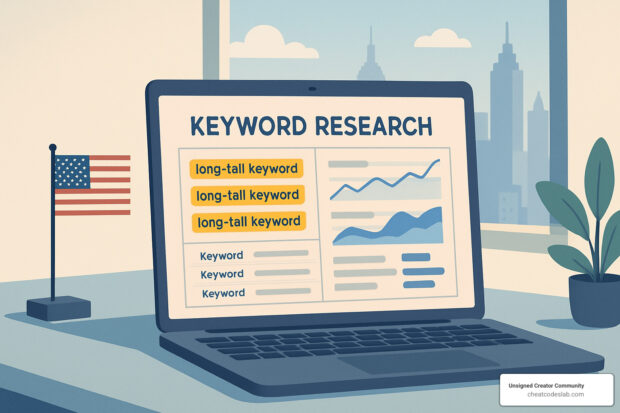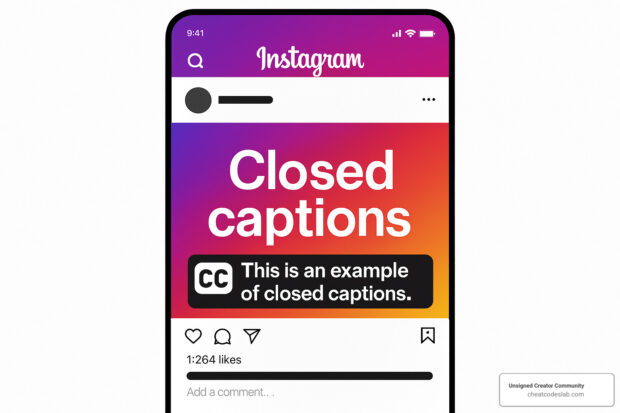
On-page SEO tips: 10 Powerful Ways for Better Rankings 2025
Why On-Page SEO Tips Make or Break Your Rankings
On-page SEO tips help you optimize individual web pages to rank higher in search results and drive more organic traffic. These strategies focus on elements you control directly – like content, HTML tags, and page structure.
Essential On-Page SEO Tips for Better Rankings:
- Keywords: Place target keywords in titles, headings, and first 100 words naturally
- Title Tags: Keep under 60 characters with primary keyword near the front
- Meta Descriptions: Write compelling 155-160 character summaries with keywords
- Headings: Use H1 for main title, H2-H3 for subheadings with keyword variations
- Content Quality: Create unique, helpful content that matches search intent
- Internal Links: Connect related pages with descriptive anchor text
- Images: Optimize with descriptive filenames and alt text under 125 characters
- Page Speed: Ensure fast loading times and mobile-friendly design
- URLs: Use short, keyword-rich, descriptive URLs with hyphens
Small changes to these on-page elements can have a big impact on your rankings and traffic. Research shows that Google rewrites title tags 61.6% of the time, and pages with optimized meta descriptions see higher click-through rates.
Unlike off-page SEO (which focuses on backlinks and external signals), on-page SEO gives you complete control over optimization. You can implement these changes immediately without waiting for other websites to link to you.
I’m digitaljeff, and over the past 20 years I’ve helped build brands and optimize content distribution strategies that generated over 1 billion social media views. Through my work with content creators and digital marketers, I’ve seen how effective on-page SEO tips can transform struggling websites into traffic magnets.
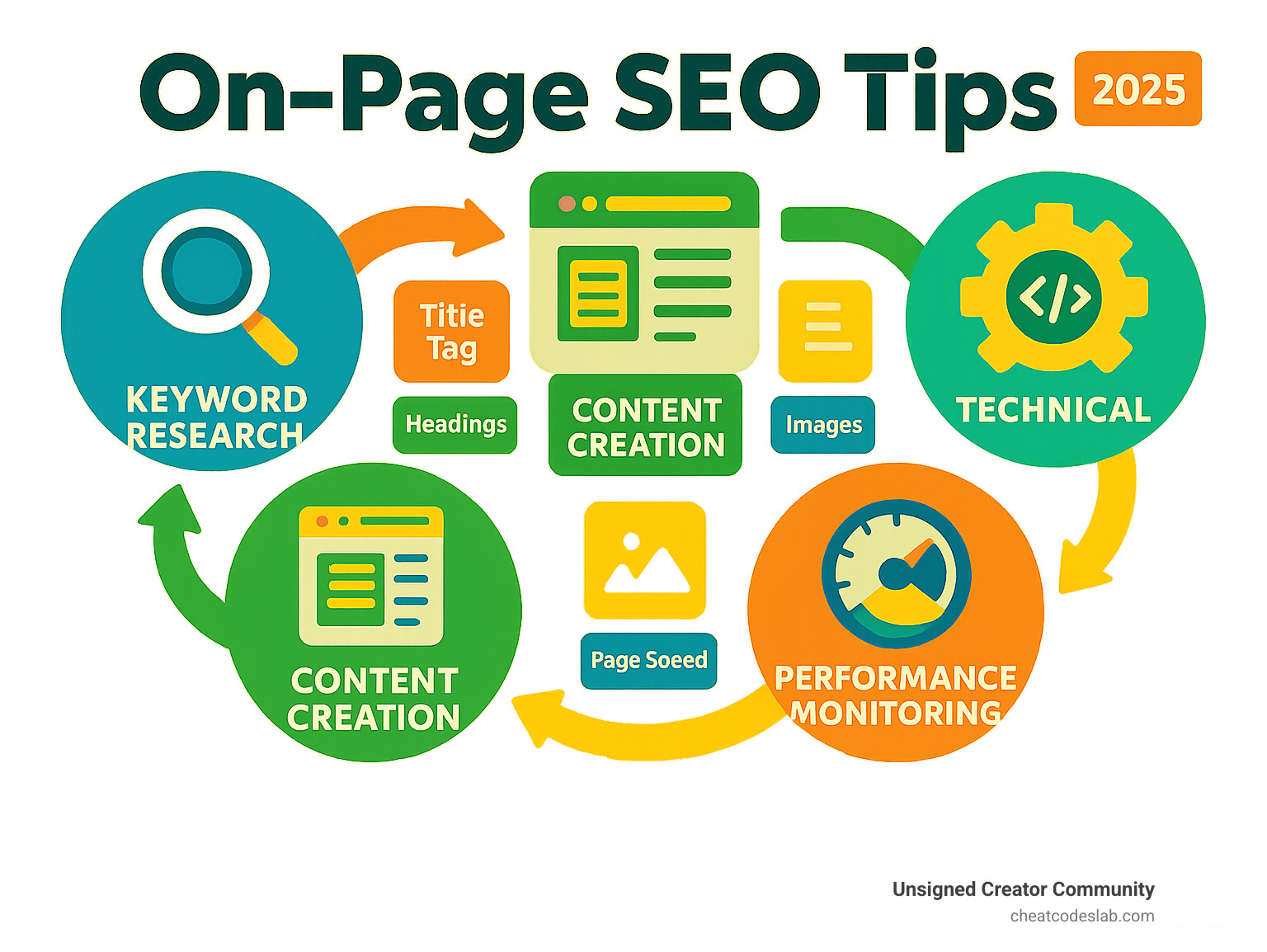
On-page SEO tips word roundup:
On-Page SEO Tips: The Complete Checklist
Understand On-Page vs Off-Page vs Technical SEO
Let’s start with something that confuses a lot of creators: what exactly are on-page SEO tips, and how do they fit into the bigger picture?
On-page SEO is everything you control directly on your webpage. This includes your content quality and keyword usage, title tags and meta descriptions, heading organization with H1, H2, and H3 tags, internal linking between pages, image optimization, and URL structure. The best part? You can implement these changes right now without waiting for anyone else.
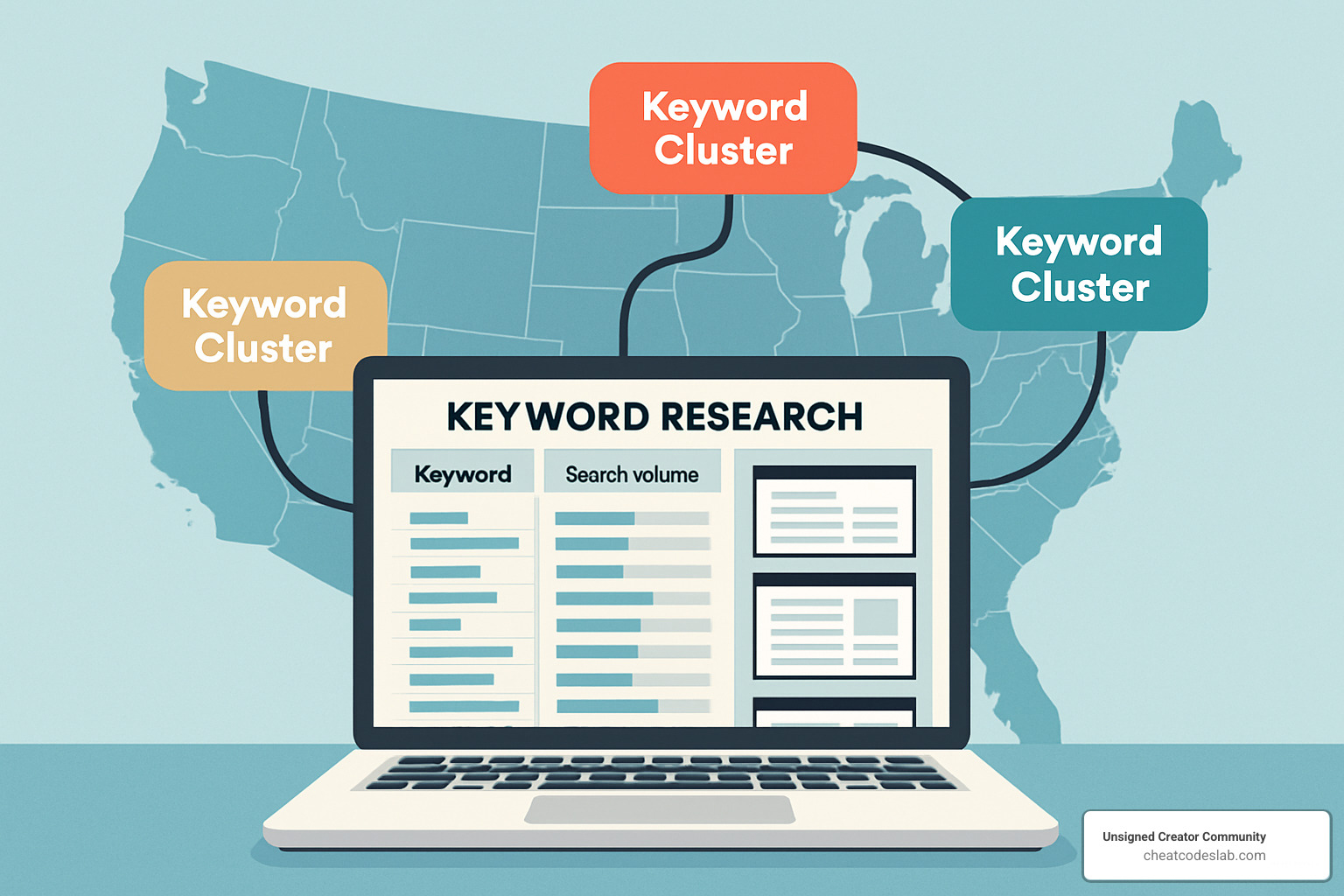
Off-page SEO focuses on building your site’s reputation through external signals. This means backlinks from other websites, social media mentions, brand citations, and online reviews.
Technical SEO ensures search engines can actually find and understand your site. This covers site speed and Core Web Vitals, mobile-friendliness, SSL certificates for HTTPS security, XML sitemaps, and robots.txt files.
According to Google’s own documentation on how search works, their algorithm evaluates pages using relevance signals (mainly on-page factors) and authority signals (primarily off-page factors).
| On-Page SEO | Off-Page SEO |
|---|---|
| You control completely | Depends on others |
| Immediate implementation | Takes time to build |
| Content and HTML optimization | Link building and mentions |
| Affects individual pages | Builds domain authority |
| Foundation for rankings | Boosts ranking potential |
This is why on-page SEO tips are so valuable for creators just starting out. You don’t need to wait for other websites to notice you – you can start ranking better today.
Keyword Research & Placement: On-page SEO Tips for Strategic Targeting
Here’s where many creators go wrong: they chase after broad, high-competition keywords like “fitness” when they should target specific phrases their audience actually searches for. Someone looking for “beginner home workout routines for busy parents” is much more likely to engage with your content.
Smart keyword research starts with seed keywords related to your main topic, then branches out into what real people are asking. Focus on question-based keywords using what, how, why, and when. Long-tail variations with 3-5 words show clear intent and often convert better.
Don’t forget related terms and synonyms that Google associates with your topic. Modern search algorithms understand context, so using natural variations actually helps more than repeating the exact same phrase.
Once you’ve found your target keywords, strategic placement makes all the difference. Your primary keyword should appear in the first 100 words to signal topical relevance immediately. Include your main keyword near the beginning of your title tag, but keep it natural and compelling.
Your H1 heading should contain the primary keyword, while H2 and H3 subheadings work perfectly for keyword variations and related terms. Throughout your content, sprinkle keywords naturally – Google’s algorithms are sophisticated enough to understand context without keyword stuffing.
Forget about hitting a specific keyword density percentage. Instead of repeating “content marketing strategy” everywhere, use natural variations like “content marketing approach,” “content strategy planning,” and “marketing content tactics.”
For more detailed guidance on creating SEO-optimized content, check out our SEO Content Tips resource.
Titles, Metas & Headings: On-page SEO Tips for Clicks & Clarity
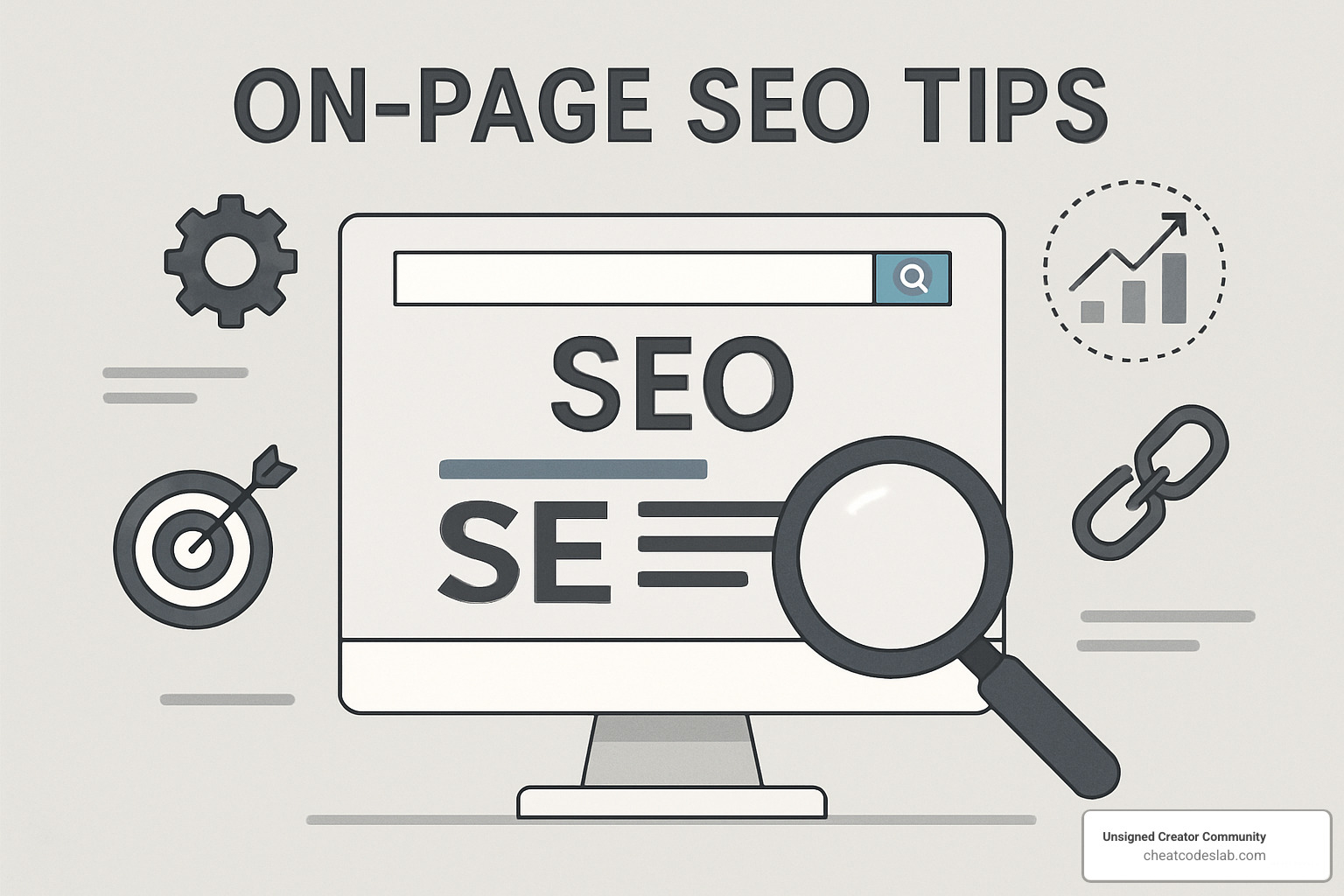
Your title tags and meta descriptions are like movie trailers for your content. They need to grab attention in search results and convince people your page has exactly what they’re looking for.
Title tag optimization starts with length – keep them between 50-60 characters to avoid getting cut off in search results. Put your primary keyword near the front, include a clear benefit or value proposition, and add your brand name at the end if space allows.
Here’s what works: “On-Page SEO Tips: 13 Strategies That Boost Rankings” versus what doesn’t: “SEO TIPS SEO GUIDE BEST SEO TIPS FOR RANKING.” The first version is clear, specific, and natural.
Research shows Google rewrites title tags 61.6% of the time, usually when titles are too long, too short, or don’t match the page content well.
Meta descriptions don’t directly impact rankings, but they dramatically affect whether people click your result. Keep them between 155-160 characters on desktop and around 120 characters for mobile searches.
Winning meta descriptions include your target keyword (Google bolds matching terms), use active voice for impact, include a clear call-to-action, and match what searchers actually want. Avoid duplicate descriptions across pages.
Heading structure creates a roadmap for both users and search engines. Use one H1 per page that contains your primary keyword and matches your title tag concept. Multiple H2s work great for main sections with keyword variations, while H3s and beyond handle subsections and detailed points.
Content, Links & Media Optimization
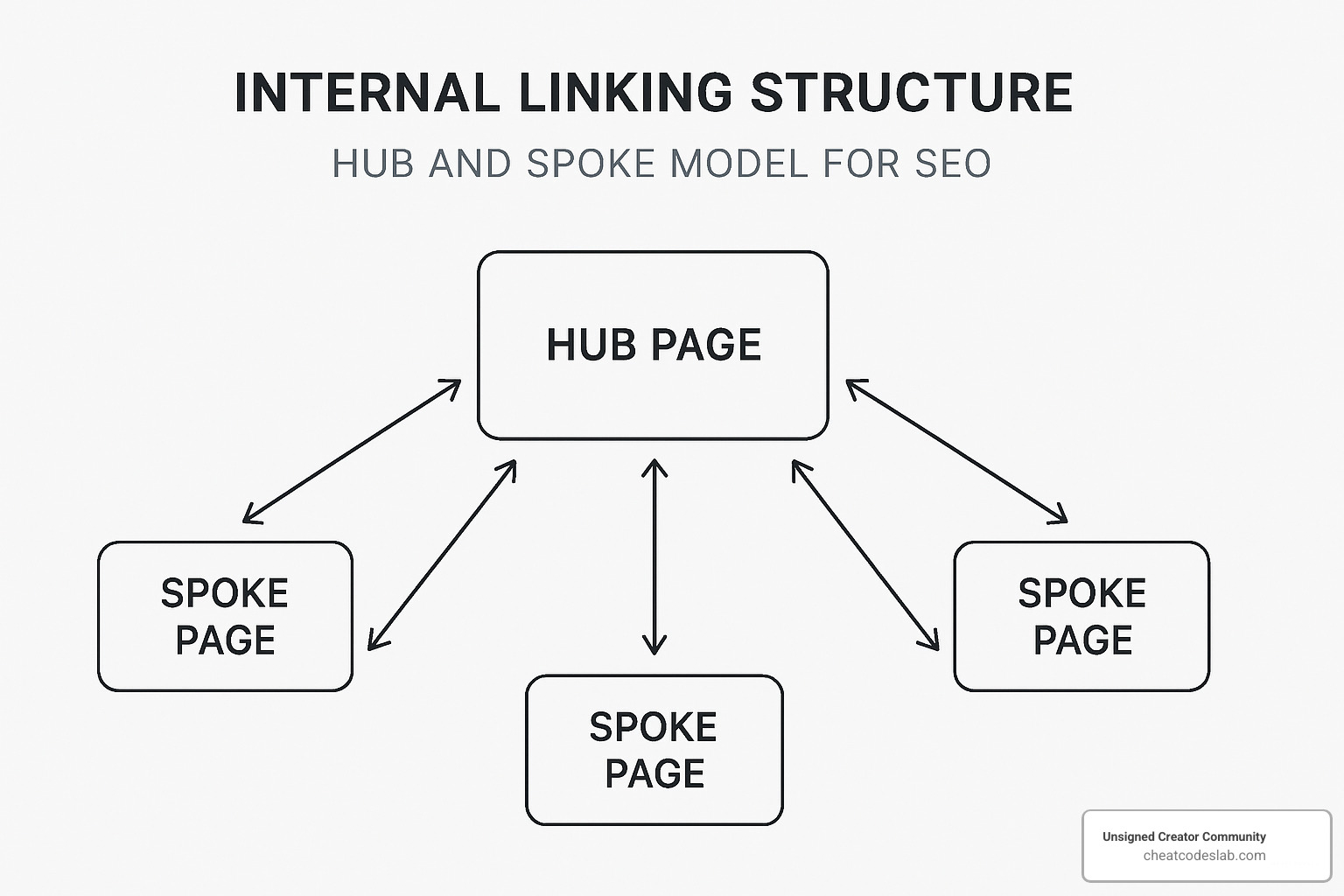
Great content is still the foundation of effective on-page SEO tips, but creating amazing content isn’t enough anymore. You need to optimize how that content connects to other pages and incorporates media elements that keep people engaged.
Content quality centers around E-E-A-T – Experience, Expertise, Authoritativeness, and Trustworthiness. Google’s quality guidelines emphasize these factors because they want to surface content from people who actually know what they’re talking about.
Experience means showing first-hand knowledge through personal stories, case studies, and behind-the-scenes insights. Expertise comes from comprehensive coverage using industry terminology correctly and citing credible sources. Authoritativeness builds through author bios with relevant credentials, and Trustworthiness develops from accurate, up-to-date information.
Internal linking strategy helps search engines find your content and understand how pages relate to each other. Use descriptive anchor text instead of generic phrases like “click here.” Connect related topics naturally without overdoing it – about 2-5 internal links per 1000 words usually works well.
External linking to high-quality sources can actually improve your SEO by showing Google you’re connected to authoritative content in your niche. Link to reputable sources using descriptive anchor text.
Image optimization drives significant traffic through Google Images and improves user engagement. Use descriptive filenames like “on-page-seo-checklist.jpg” instead of “IMG_001.jpg.” Write alt text under 125 characters that describes the image for accessibility and SEO.
Compress images to keep file sizes under 100KB when possible, and use relevant images – custom graphics often outperform generic stock photos.
For more advanced optimization strategies, explore our Advanced SEO Techniques guide.
Technical Signals & Schema for Rich Results
The technical foundation of your on-page SEO tips can make or break your rankings, especially as Google’s algorithm increasingly prioritizes user experience signals.
Core Web Vitals are confirmed ranking factors that measure real user experience. Largest Contentful Paint (LCP) measures how quickly your main content loads – aim for under 2.5 seconds. First Input Delay (FID) tracks how quickly your page responds to user interactions – target under 100 milliseconds. Cumulative Layout Shift (CLS) measures how much your page layout shifts during loading – keep it under 0.1.
Use Google’s PageSpeed Insights to test your pages and get specific recommendations for improvement.
Mobile-first optimization is non-negotiable since Google uses mobile-first indexing. They primarily use the mobile version of your content for ranking and indexing. Ensure responsive design that adapts to all screen sizes, fast loading on mobile networks, and easy-to-tap buttons and links.
HTTPS is a confirmed ranking factor, and Google marks HTTP sites as “not secure” in Chrome. This security warning hurts user trust and click-through rates.
Clean URL structure helps both users and search engines understand your page content. Keep URLs short and descriptive, use hyphens to separate words, include your target keyword, and use lowercase letters.
Schema markup helps search engines understand your content better and can open up rich snippets that make your listings stand out. Common schema types include Article for blog posts, FAQ for frequently asked questions, How-to for step-by-step guides, and Review for product or service reviews.
Featured snippet optimization can get you to “position zero” and dramatically increase click-through rates. Identify opportunities by looking for keywords where featured snippets already exist, match the format by providing concise answers, and answer directly with clear, concise responses to common questions.
For comprehensive guidance on implementing schema markup, visit our Schema Markup Guide.
Conclusion & Next Steps
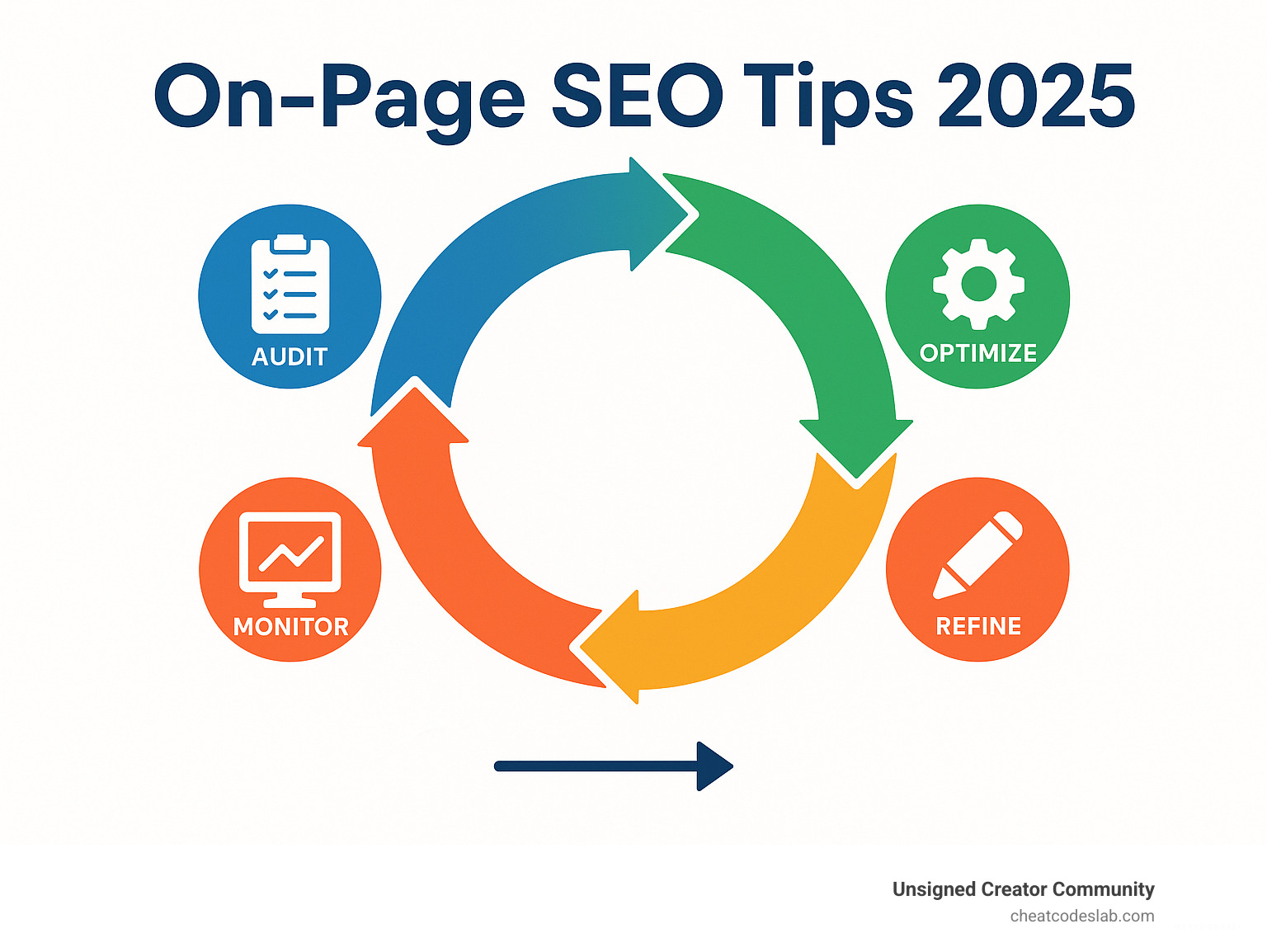
You’ve now got a complete toolkit of on-page SEO tips that can transform your search rankings. But here’s the thing – knowing these strategies is just the beginning. The real magic happens when you put them into practice consistently.
At the Unsigned Creator Community by CheatCodesLab, we’ve watched countless creators go from struggling with search visibility to dominating their niches. The difference? They treated SEO as an ongoing relationship, not a one-night stand.
Your journey starts with a simple audit. Pick three of your most important pages and review them against the checklist we’ve covered. You’ll probably spot opportunities immediately – maybe your title tags are too long, or you’re missing internal links to related content.
The beauty of on-page SEO tips is that you control the timeline. Unlike waiting months for backlinks to build your authority, you can optimize your meta descriptions this afternoon and see improved click-through rates by next week.
Performance tracking makes all the difference. Set up a simple system to monitor your rankings and traffic. When you see a page climbing from position 15 to position 8, you’ll know your optimization efforts are working.
Content refresh becomes your secret weapon over time. Every few months, revisit your top-performing pages. Update those statistics, fix any broken links, and add fresh insights based on what you’ve learned.
The most successful creators we work with follow a continuous improvement cycle. They audit their pages, implement optimizations, monitor the results, then refine their approach based on what works.
On-page SEO tips work best as part of a bigger strategy. These fundamentals create the foundation, but you’ll want to explore our SEO Strategy Tools to streamline your workflow and scale your efforts efficiently.
If you’re just getting started, our SEO-ready starter kit gives you everything you need to implement these strategies from day one.
The search landscape keeps evolving, but these core principles remain rock-solid. Focus on creating genuinely helpful content for your audience, then use these technical optimizations to help search engines understand and rank that content properly.
Your future self will thank you for starting today.











